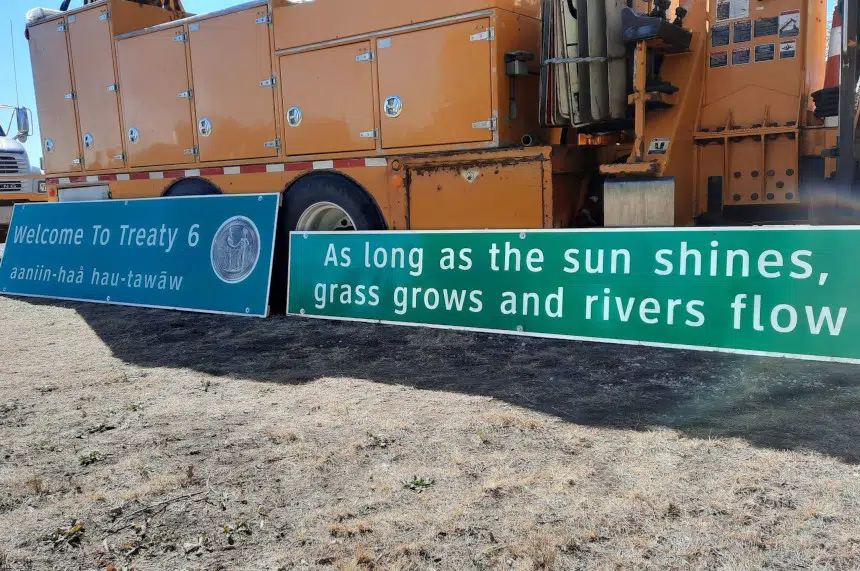Five-foot-high, 12-foot-wide signs now stand alongside Highway 11, declaring to all those thousands who pass by every day that they are on Treaty territory.
The signs were installed Monday afternoon near Bladworth after a ceremony on a farm in the town. They declare to those heading south that they’re entering Treaty 4 territory, and for those heading north that they’re entering Treaty 6 territory.
Mary Culbertson, the Treaty Commissioner of Saskatchewan, said in some ways, the significance and importance of the signs is unexplainable.
“No one would think in 2022 that these weren’t there or they’ve never been there. It’ll spark dialogue. It’ll create education. It’s going to combat the miseducation that our society has had about Treaties and about the lands that they live on,” said Culbertson.
She said so many people will be proud to see those signs.
“They’ll stop (and) they’ll take pictures at the signs. They’ll know that their territory, that all our ancestors lived on and our people here live on today, First Nations and non-First Nations and newcomers, that these are Treaty territories,” she said.
The initiative is a bit personal for Culbertson, who admitted she got a bit emotional during the ceremony Monday morning.
“I wish I grew up driving down these highways seeing Treaty signs,” she said.
Originally, the idea first came about as possibly putting up a sign on a local farmer’s land — the same farmer who hosted the gathering on Monday.
But Culbertson said they went further and wanted to see if the province would take it on in part to protect the signs, because if someone were to deface or vandalize a provincial sign, then it will be fixed or put back up.
“We have had horrible things happen in this province but it’s waking people up. It’s woken people up to that this is all our land and we should be safe on our lands, and we do have those barriers in place that we’ve got to get by, and we’ll get there one day where everyone can be safe on these lands,” said Culbertson.
The signs make the province the first in Canada to mark a Treaty boundary along a major highway.
Don McMorris — the minister responsible for First Nations, Métis and Northern Affairs — said the government wanted to be a part of this because it’s another step toward reconciliation.
He mentioned another step toward reconciliation taken by this government: Mandating Treaty education in the provincial curriculum in 2008. McMorris said he didn’t learn anything about the Treaties when he was in high school.
“I learned about treaties in Europe. I would not have known exactly where the border was between Treaty 4 and Treaty 6, and I would think the vast majority of the people would not know and now it may start the conversation in the car as they drive by, and I think that can only benefit all people in Saskatchewan because we’re all Treaty people,” said McMorris.
One of the most important part of the new signs is the education it will bring, according to Lt.-Gov. Russ Mirasty.
“What they mean and generating that conversation where maybe people don’t know anything about the Treaties,” said Mirasty.
The signs are in English, but also have greetings in local languages including Anishinaabe, Saulteaux, Dakota, Lakota, Nakota, and Cree.
“I think it’s the idea of bringing people together through their languages,” said Mirasty. “For Indigenous people to see their own language on these important signs is such an important aspect of it.”
The signs are the first, but Culbertson said groups will be looking out for the next place signs should be placed. McMorris said the government will also look at other opportunities for more signs, though he also said that not all of the six Treaty territories in Saskatchewan have major highways running through them.











